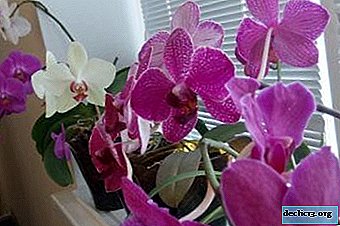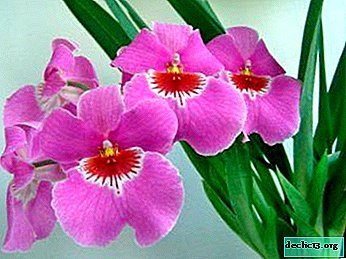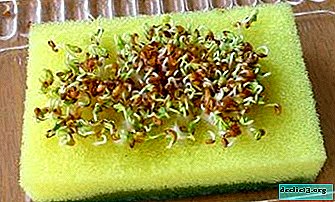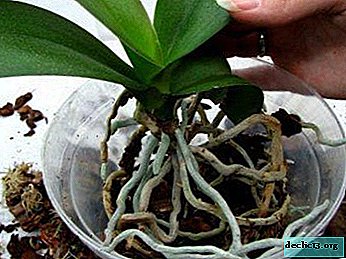What plant is an orchid, photophilous or shade-loving and how much sun is needed at home for this flower?

In order to determine whether a light-loving or shade-loving plant is an orchid, we must remember that it is a child of a tropical climate, so the role of proper lighting can hardly be overestimated. Under the natural conditions of the tropics, daylight hours last, on average, half a day. From this it follows that the answer to the question whether the flower loves the sun or shadow is unambiguous.
In our climate, the difference in daylight hours between summer and winter reaches 8 hours. Therefore, in winter, at home, for orchids, additional lighting will be required, and in summer, care must be taken so that the delicate plant does not suffer from an excess of light and temperature.
Features of home care
- It is advisable after you bring the flower from the store to provide it with quarantine for two weeks. The orchid should be placed separately from other plants, protected from direct sunlight. Also during this period it is undesirable to water it, just watch the leaves and its other parts. At the end of quarantine, you can gradually accustom the orchid to sunlight and watering.
- Despite the fact that orchids vary in temperature, almost all of their species will feel comfortable at temperatures of 18-27 degrees during the day and 13-24 degrees at night. You can read all about the suitable temperature for keeping an orchid here.
 Water and spray should be soft water. For example, distilled boiled, rain or distilled. You can feed during watering.
Water and spray should be soft water. For example, distilled boiled, rain or distilled. You can feed during watering.- Humidity is another important factor. Orchids love moist air, so in the winter during the heating season and in the sultry summer, you need to take care of additional moisture. A good help in this would be indoor aquariums with fish or terrariums with water.
- Fresh air is necessary not only for people, but also for flowers. Do not forget to often air the room with your plants.
- An orchid transplant is not needed if it has recently been brought from a store. The plant is able to grow in its substrate for about 2 years.
Watch a video about the rules for caring for orchids at home:
You will find more information about orchid conditions here.
Is it photophilous or shade-loving?
Orchids, like any plant, sunlight is essential for photosynthesis. Photosynthesis is a process that occurs due to the energy of light, as a result of which many organic substances are synthesized from carbon dioxide, water and minerals of the soil. With a lack of light, these substances are formed a little, the plant is starving. In addition, with a lack of lighting, pathogenic microorganisms actively multiply, which leads the flower to various diseases.
How much sun does a flower need?
All orchids can be divided into three groups according to their need for light:
- Photophilous species. They require plenty of sunlight. These include some types of vanda, oncidiums, dendrobiums and several others. This group is least suited for indoor maintenance. Optimum illumination - 30-40 thousand lux.
- Plants requiring moderate lighting. This includes most indoor orchids. The range of illumination is 15-30 thousand lux.
- Shade-loving Orchidsrequiring for normal development from 5 to 15 thousand lux. This group includes phalaenopsis, shoes, anectochylus, hemaria and others. These plants can be successfully maintained year-round under artificial lighting.
Light intensity and duration
 In our climate, in late spring and early summer, the intensity and duration of natural light is the strongest. Under these conditions, all orchids need protection from direct sunlight - shading.
In our climate, in late spring and early summer, the intensity and duration of natural light is the strongest. Under these conditions, all orchids need protection from direct sunlight - shading.
In the spring, shade is necessary for adaptation: during the winter, the plant is weaned from such bright light and its delicate leaves can suffer from burns. In summer, shading additionally serves to slightly reduce the temperature. In the fall, with a decrease in the intensity of sunlight, shading can be omitted. In species such as vandas, oncidiums, dendrobiums, relative peace sets in in the fall. There is a ripening of young shoots, flower buds are laid. The sun no longer burns, but simply caresses.
In addition to intensity, an equally important factor is the duration of daylight hours. The normal duration for orchids is 12 hours. If daylight hours are shorter than 10 hours, then additional illumination is necessary.
Where to put?
In a house or apartment, it is better to put an orchid on the window on the south sideThese flowers love the light. At the same time, you need to remember that they can not stand direct sunlight, so in this case, you should move the flower deep into the room. Or pull gauze or tulle over the window.
TIP: Ideal if the windows of your apartment or house face both the south and the north. Then you can transfer orchids from room to room, depending on the position of the sun. Shade-loving plants also feel great indoors.When are extra lamps needed?
 From mid-October to mid-April orchids will need extra light. This applies to all types of these plants, and if you also have light-loving species, then lighting with special lamps is simply vital.
From mid-October to mid-April orchids will need extra light. This applies to all types of these plants, and if you also have light-loving species, then lighting with special lamps is simply vital.
Increase daylight hours in the morning and evening with the help of fluorescent lamps. They practically do not produce heat and their light is most suitable for your orchids. For these purposes, special fluorescent lamps are used, or, less preferred, conventional fluorescent lamps with a power of about 60 watts. The distance from the lamp to the plant should be no more than 30 cm.
Daylight hours for an orchid in the winter should last from 8 in the morning to 20 in the evening. Night illumination of a flower is unacceptable.
You will learn how to choose the right lamp for backlighting and organize additional lighting in this article.
Watch the video about the additional illumination of orchids:
Does the shadow like?
Starting in March, when the sun rises higher and higher above the horizon, there is an increased risk that thermal burns may appear on delicate leaves. First of all, this refers to such a common type of orchid as phalaenopsis. In this case, the window should be shaded. This can be done using blinds, light curtains, thick white paper or matte film. You can also rearrange, if possible, plants 1-1.5 meters from the window.
If you are going on vacation, you should not risk shading the southern window in order to avoid negative consequences. The best option is to rearrange the orchid on the bedside table, refrigerator and even on the floor.
Errors and their consequences
As stated above orchids should avoid direct sunlight. The consequences of prolonged exposure to direct sunlight are thermal burns of leaves. In severe cases, a characteristic dark spot may form on the leaves. Such a sheet must be deleted.
IMPORTANT: Another sign of an overabundance of the sun is the pigmentation of the leaves, which has a hue from pink to purple, more often cherry. This is not as bad as burns. For the plant, this pigmented tan is not a problem. But still, pigmentation is best avoided.With a lack of light, flowers begin to hurt. A sure sign of this is the narrow, pale, elongated upper leaves, moreover, inclined to the light source. Another sign - the plant has stopped growing. So it's time to turn on additional lighting.
Conclusion
Now you know the answer to the question, is this plant photophilous or not, and how proper lighting affects the growth and health of the flower. If you do everything in science, there will be no problems. The main thing is not to forget the immortal phrase: “Let there be light!”

 Water and spray should be soft water. For example, distilled boiled, rain or distilled. You can feed during watering.
Water and spray should be soft water. For example, distilled boiled, rain or distilled. You can feed during watering.















